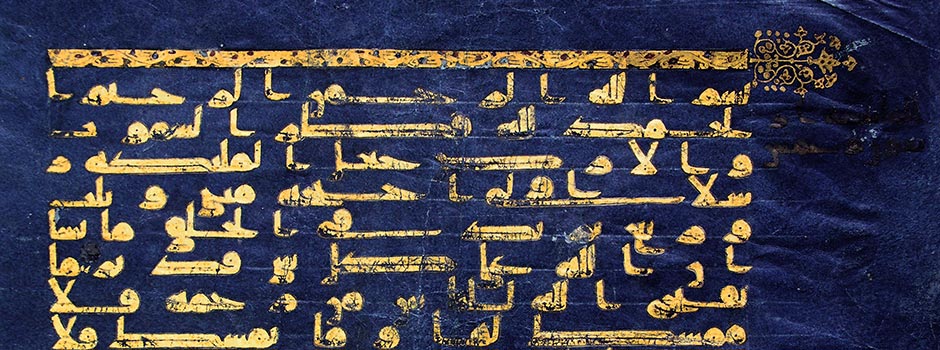
MAJOR TRAVELING EXHIBITION OF ISLAMIC ART ORGANIZED BY FOCUS-ABENGOA FOUNDATION PREMIERES THIS OCTOBER IN SEVILLE, SPAIN Nur: Light in Art and Science from the Islamic World
Jun 30, 2013 FEATURE, Art Collection

Featuring 150 objects from public and private collections in Europe, North Africa, the Middle East, and the United States, Nur: Light in Art and Science from the Islamic World will explore the use and meaning of light in Islamic art and science, and demonstrate how light is a unifying motif in Islamic civilizations worldwide. The exhibition, organized and developed by Islamic art and culture expert Dr. Sabiha Al Khemir will include a significant number of objects that have never before been presented to the public, from artworks to rare manuscripts and scientific objects. Following the exhibition's debut in Seville at the Focus-Abengoa Foundation's historic 17th-century building, the Hospital de los Venerables Sacerdotes, from October 25, 2013, to February 9, 2014, 'Nur: Light in Art and Science from the Islamic World' will be on view at the Dallas Museum of Art in Texas from March 30, 2014, to June 29, 2014.
Deriving its title from the Arabic word for light in both the physical and metaphysical sense, Nur will be organized thematically into two major sections: an art section showcasing innovations in an artistic technique that enhances the effect of light, and a section focusing on scientific fields which are related to light or contributed to enlightenment. Encompassing works dating from the 9th through early 20th centuries and originating from a wide geographical area, from Spain to Central Asia, the exhibition will include manuscripts illuminated with gold and colour pigments, ceramics painted with lustre, inlay metalwork decorated in silver and gold, and objects made from precious and semi-precious stones.
Scientific objects featured in the exhibition include equatorial sundials, astrolabes, and anatomical instruments, all of which are examples of the Islamic world's influence on the Renaissance and scientific thought. In addition to showcasing the use of light in Islamic art and science, Nur will demonstrate how Spain has bridged the Islamic world and Europe, serving as an entry point for Islamic discoveries in fields such as medicine, geometry, and astronomy, as well as specific inventions such as the lustre technique.
"For centuries, Spain has served as a bridge between Islamic and Western civilizations. The Focus-Abengoa Foundation's organization of this travelling exhibition continues this tradition by allowing visitors to Seville and Dallas to discover themes and see works from the Islamic world, some of which have never been exhibited before," said Dr Sabiha Al Khemir, the exhibition's project director and Senior Advisor of Islamic Art at the Dallas Museum of Art. "The eleven centuries and seventeen countries represented in Nur demonstrate not only the tradition of skill and craftsmanship across the Islamic world but also the sheer beauty that Islamic culture has produced and Islamic civilization's contribution to humanity's pool of knowledge."
The exhibition will begin with a selection of objects that visually express the idea of light in their design, including a bowl from late 13th-century Iran and a ceremonial shield from 17th-century India or Persia, both of which feature suns at their centres emanating stylized rays of light. It will also explore the idea of light as a shared metaphor, with pieces representing Muslim, Christian, and Jewish cultures. Screens throughout the exhibition will present the rich details of the objects on view, highlighting the visual language and vocabulary of Islamic art and its multi-layered nature, with ornate flourishes and calligraphic writing. The screens also bring to the fore the synthesis of the exhibition’s themes, adding to the didactic dimension.
The exhibition will include artworks and secular objects from institutional and private collections, including a significant number of objects from Spanish collections that will be travelling to the United States for the first time for the Dallas Museum of Art’s presentation of Nur.
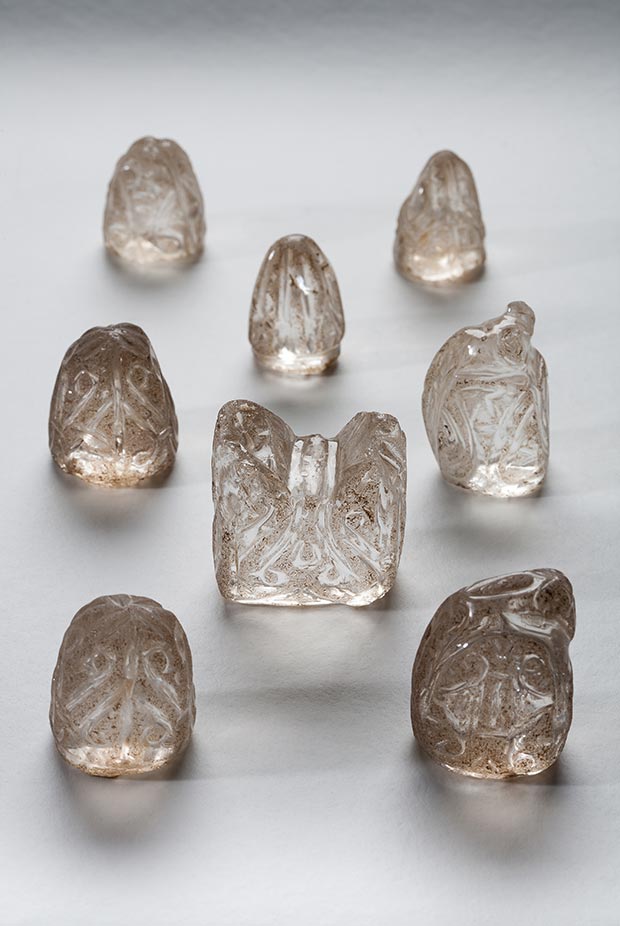 A series of 11th-century crystal chess pieces from the Museo da Catedral in Ourense, Spain / Courtesy of The Focus-Abengoa Foundation
A series of 11th-century crystal chess pieces from the Museo da Catedral in Ourense, Spain / Courtesy of The Focus-Abengoa Foundation
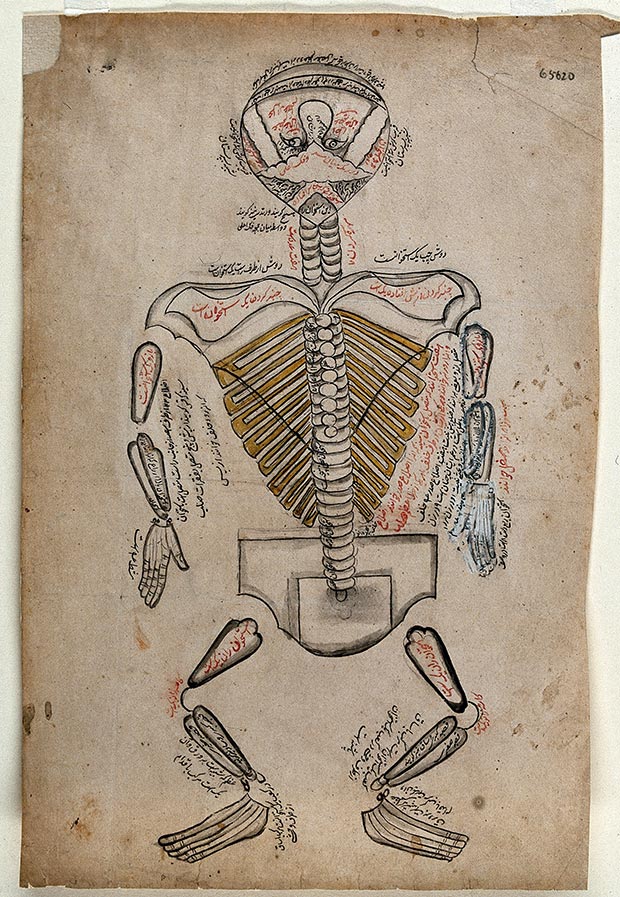 Anatomical illustration showing nerves of the human body, Iran, 19th century, 2.6x16.9 cm. Wellcome Library, London / Courtesy of The Focus-Abengoa Foundation
Anatomical illustration showing nerves of the human body, Iran, 19th century, 2.6x16.9 cm. Wellcome Library, London / Courtesy of The Focus-Abengoa Foundation
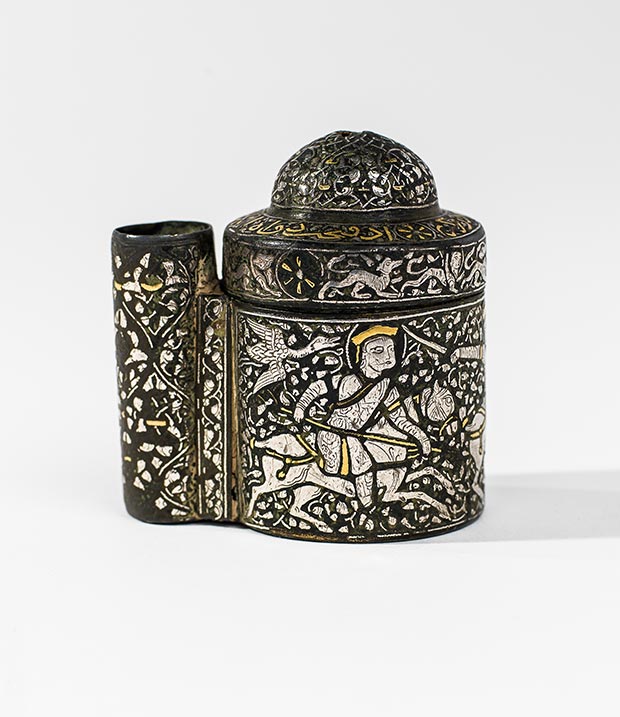 Inkwell, Al Jazira or West Persia, ca. 1275 AD. Copper alloy, gold silver, lead. Furusiyya Art Foundation, Lichtenstein / Courtesy of The Focus-Abengoa Foundation / Photo © Noel Adams
Inkwell, Al Jazira or West Persia, ca. 1275 AD. Copper alloy, gold silver, lead. Furusiyya Art Foundation, Lichtenstein / Courtesy of The Focus-Abengoa Foundation / Photo © Noel Adams
 Two pages from a Qur'an manuscript, gold in Kufi script on blue parchment, Raqqada Museum of Islamic Arts, Tunisia / Courtesy of The Focus-Abengoa Foundation
Two pages from a Qur'an manuscript, gold in Kufi script on blue parchment, Raqqada Museum of Islamic Arts, Tunisia / Courtesy of The Focus-Abengoa Foundation
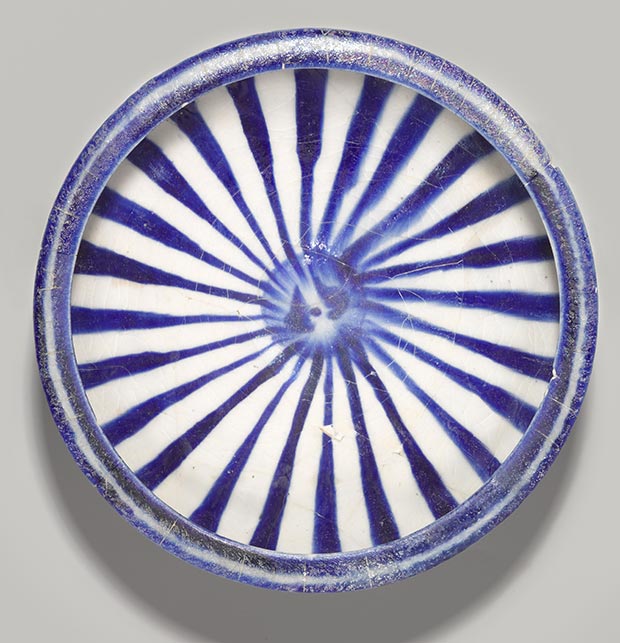 13th century Blue and White Bowl painted in cobalt blue, under a transparent glaze from Iran, Kashan, Brooklyn Museum / Courtesy of The Focus-Abengoa Foundation
13th century Blue and White Bowl painted in cobalt blue, under a transparent glaze from Iran, Kashan, Brooklyn Museum / Courtesy of The Focus-Abengoa Foundation
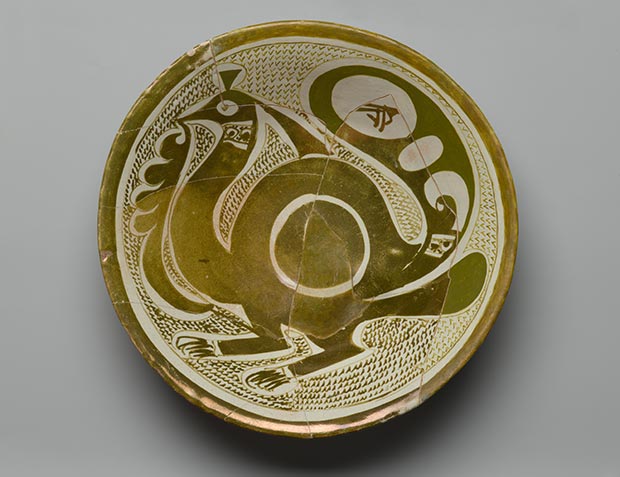 9th - 10th century Bowl with Bird, lustre painted, Brooklyn Museum / Courtesy of The Focus-Abengoa Foundation
9th - 10th century Bowl with Bird, lustre painted, Brooklyn Museum / Courtesy of The Focus-Abengoa Foundation
 Pair of Window Panels from Egypt, 15th century, Plaster glass wood. Private Collection, London / Courtesy of The Focus-Abengoa Foundation / Photo © Noel Adams
Pair of Window Panels from Egypt, 15th century, Plaster glass wood. Private Collection, London / Courtesy of The Focus-Abengoa Foundation / Photo © Noel Adams
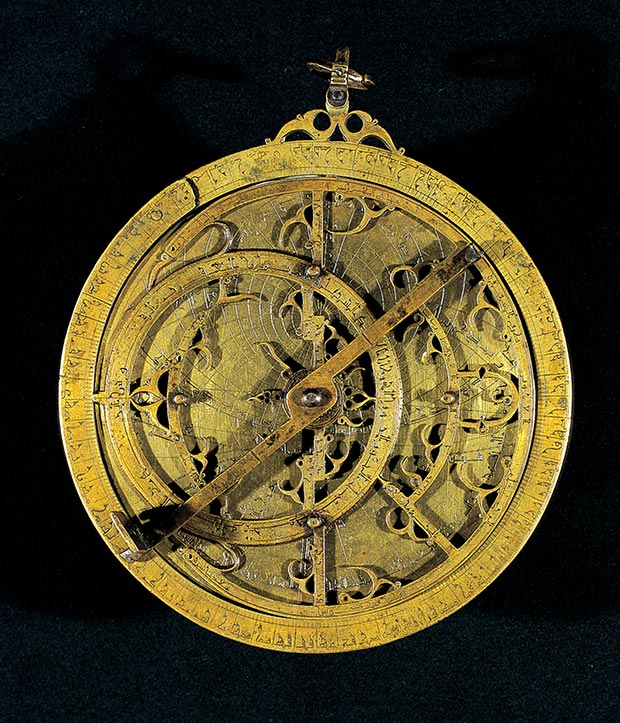 Planispheric Astrolabe, Cast, engraved brass, by Ahmad ibn Husayn ibn Baso, Spain, Real Academia de la Historia, Madrid / Courtesy of The Focus-Abengoa Foundation
Planispheric Astrolabe, Cast, engraved brass, by Ahmad ibn Husayn ibn Baso, Spain, Real Academia de la Historia, Madrid / Courtesy of The Focus-Abengoa Foundation
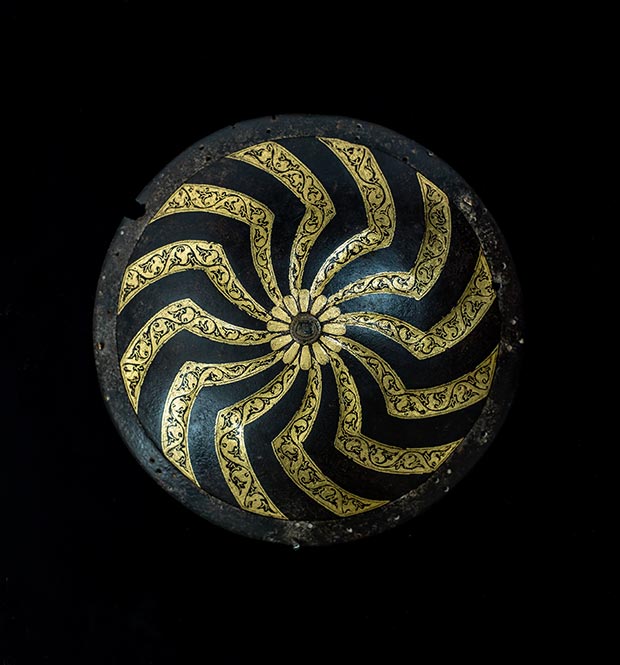 17th century Shield Boss from India or Persia. Steel and gold. Furusiyya Art Foundation, Lichtenstein / Courtesy of The Focus-Abengoa Foundation / Photo © Noel Adams
17th century Shield Boss from India or Persia. Steel and gold. Furusiyya Art Foundation, Lichtenstein / Courtesy of The Focus-Abengoa Foundation / Photo © Noel Adams
A global leader in developing renewable energies, Abengoa, along with the Focus-Abengoa Foundation, chose to organize their first travelling exhibition about the subject of light to raise awareness about its importance in science, art, and culture. "Abengoa's leadership in solar energy and the Islamic history of the city of Seville and Andalusia are the fundamental elements that led us to create this exhibition. Sabiha's vision in Nur explores the universality and the constancy of light in Islamic art and culture while delving into our conscience and strengthening our ability to appreciate the beauty and the aesthetic inherent in these pieces", says Anabel Morillo Len, director general of the Focus-Abengoa Foundation. "As we increase our presence in the United States and extend our cultural reach, we are delighted to partner with the Dallas Museum of Art with the forthcoming presentation of Nur."
"We are pleased to be partnering with the Focus-Abengoa Foundation to bring Nur to Dallas and to share with our audiences the tremendous breadth, innovative quality, and artistry of Islamic material culture," said Maxwell L. Anderson, the DMA's Eugene McDermott Director. Nur exemplifies the DMA's commitment to broadening and enriching the experiences we offer our community. We look forward to continuing to enhance the presence of Islamic art in our exhibitions and collections through our international collaborations and cultural exchange program, DMX, led by Dr Sabiha Al Khemir."
Dr Sabiha Al Khemir is a writer, artist, and expert in Islamic art whose work is concerned with bridging cultural divides and spurring international dialogue. Over the past four years, Dr Al Khemir has been working with the Focus-Abengoa Foundation on the development of 'Nur: Light in Art and Science form the Islamic World.' In 2012, Dr Al Khemir was appointed as the first Senior Advisor of Islamic Art at the Dallas Museum of Art, where she is serving a three-year term supporting the museum in building partnerships with art institutions around the globe.
Prior to her appointment at the Dallas Museum of Art, she was the project director and catalogue author for the exhibition 'Beauty and Belief: Crossing Bridges with the Arts of Islamic Culture,' the largest travelling survey of Islamic art ever assembled in the United States (2012). Dr Al Khemir previously served as the first Director of the Museum of Islamic Art in Doha, Qatar, from 2006-2008, and as its Chief Curator from 2003-2006. She also organized and wrote the catalogue (in French, Arabic, and English) for the Louvre exhibition 'From Cordoba to Samarkand: Masterpieces from the Museum of Islamic Art, Doha (2006)', the first museum presentation of some of the pieces that would become the core of the museum's permanent collection.
Dr Al Khemir has taught courses in Islamic art at the British Museum and has consulted for the Metropolitan Museum of Art in New York in the same field. She lectures worldwide on Islamic art and various cultural topics. She has produced television documentaries broadcast on Channel 4, U.K., published two novels, and illustrated books, including a book jacket for Nobel Prize–winning author Naguib Mahfouz. In 2008 she was honoured in Washington, D.C., by the President's Committee on Arts and Humanities. A native of Tunis, she received her B.A. in English literature from the University of Tunis and M.A. and PhD degrees in Islamic art and archaeology from London University.
The Focus-Abengoa Foundation was established in 1982 in Seville, Spain, by Abengoa with a mission to promote culture. A global leader in developing renewable energies, Abengoa has applied innovative technology solutions for sustainability in the energy and environment sectors since 1941. Abengoa's cultural work began in 1972 with the publication of two books, Temas Sevillanos (Themes of Seville) and Iconografia de Sevilla (Iconography of Seville). During the same period, Abengoa began building a collection of documents, books, and engravings on the Kingdom of Seville and by Sevillian authors. The success of these projects proved the importance of the company's involvement in cultural activities, directly benefiting society beyond the firm's core technology work, leading to the creation of the Seville Cultural Fund Foundation. Housed in a historic 17th-century building in Seville known as the Hospital de los Venerables Sacerdotes, the Focus-Abengoa Foundation today presents exhibitions, concerts, seminars, and congresses year-round. In addition to these activities, the Foundation's headquarters houses the Diego Velazquez Research Centre, the leading institution for studying and disseminating Velazquez's Baroque era and his Sevillian period, which was created by the Foundation in collaboration with the Seville city council following its acquisition of Velazquez's Santa Rufina in 2007. Past exhibitions organized by Focus-Abengoa include Recovering Antiquity in Andalusia, Three Centuries of Drawing in Seville, and El Greco: Known and Rediscovered. 'Nur: Light in Art and Science from the Islamic World' marks the first time the Focus-Abengoa Foundation is organizing an internationally travelling exhibition.
Established in 1903, the Dallas Museum of Art (DMA) ranks among the leading art institutions in the country and is distinguished by its innovative exhibitions and groundbreaking educational programs. At the heart of the Museum and its programs is its global collection, which encompasses more than 22,000 works and spans 5,000 years of history, representing a full range of world cultures. Located in the vibrant Arts District of downtown Dallas, the Museum welcomes more than half a million visitors annually and acts as a catalyst for community creativity, engaging people of all ages and backgrounds with a diverse spectrum of programming, from exhibitions and lectures to concerts, literary events, and dramatic and dance presentations. In January 2013, the DMA returned to a free general admission policy and launched DMA Friends, the first free museum membership program in the country. The Dallas Museum of Art is supported, in part, by the generosity of DMA Partners and donors, the citizens of Dallas through the City of Dallas Office of Cultural Affairs, and the Texas Commission on the Arts.
Comments
Add a comment